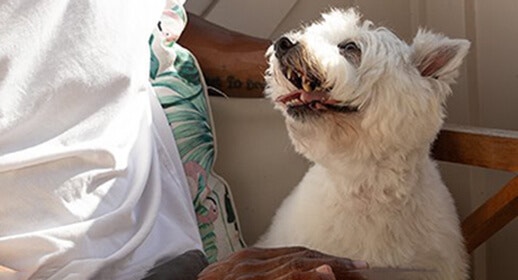- Homepage
- Discover a dog friendly world
- Dog-friendly HOMES
- What does my dog’s body language mean?


Wondering what your dog’s body language means? Keep reading to learn about the signs of friendliness, aggression, anxiety and more.
You may feel like you’ve put in plenty of training and your bond with your furry friend is so tight, you both just get each other. But it’s possible you could be missing some of their subtle communication. Read this guide to dog’s body language and discover the real meaning of your pooch’s movements and gestures.
Of course, there’s so much more to know about the complexities of dog body language, and sometimes you need to look at multiple signals to build a full picture of their mood and intentions. Here are some of the most important elements of doggy communication to have on your radar, so you can detect when they’re happy, anxious or even feeling aggressive.
Happy, friendly dog body language
Tail wagging is loose and carefree - This is a good indicator that the pooch is feeling happy, relaxed and in an approachable mood. Show them some love!
The ‘helicopter’ tail wag - Without a doubt this is a sign that the dog is excited and happy, usually used when greeting someone they love.
Eyes are half-closed, like a squint -
Squinty eyes can be a sign of friendliness or pleasure, for example, receiving a lovely belly rub or head tickle. Dogs use slow blinking or squinting to differentiate friendly eye contact from dominant eye contact, where their eyes are wide and intense.
Bottom in the air - If the dog has their bottom raised and their tail wagging high, this is them inviting you to play! They may also bark excitedly to get playtime started.
Stressed dog body language
Cowering low - Curling up tight with their head held low and their limbs and tail tucked in close to their body are some of the key elements of stressed dog body language.
Yawning - Yawning is one of the techniques dogs use to calm themselves when they are feeling stressed. An anxious yawn tends to be more prolonged and intense than a sleepy yawn.
Ears back - If feeling afraid or anxious, a dog might tuck its ears towards their head or neck.
Dominant dog body language
Intense eye contact with another dog - This says “I'm top dog here!” and can be used as a threat or challenge, especially when it’s another dog involved.
Standing up tall - The idea is to make themselves look as big as possible. They may puff their chest out too.
Rigid muscles - When a dog is asserting their dominance, their body might appear quite stiff, with tense muscles and an upright posture.
Submissive dog body language
Tail between their legs - Having their tail positioned downwards towards their bottom or between their back legs usually means that a dog is scared or anxious.
Rolling on their back - Many dogs will show their belly when approached by another dog or a person, as a sign of submission. If you don’t know the dog well, approach slowly and be gentle so you don’t spook them.
Averting their eyes - Looking into the eyes of another dog can be considered a challenge, so submissive dogs will often do anything to avoid making eye contact.
Aggressive dog body language
Tail wagging is stiff - This is one of the main aspects of aggressive dog body language. It can indicate that the dog is angry and you should approach with caution.
Wide eyes and ears pushed forward - Really wide eyes and ears pushed forward can be a warning sign that the dog may attack if provoked.
Raised hair on their neck and back - This is known as ‘raised hackles’ and is a response to their nervous system going into high alert. While this can be a sign of aggression, it can also indicate fear or excitement.
Behaviour at home
Why does my dog follow me everywhere?
If your dog follows you everywhere (even into the bathroom!), it's because they trust you and your company makes them feel safe. If they really can’t be without you by their side without becoming anxious, however, it could be a sign that your dog has separation anxiety.
Why does my dog want to sleep close to me?
If your furry pal wants to sleep near you, it's a sign of affection and connection. It could also be related to their natural instincts. Dogs are pack animals in the wild, so that makes your family your pooch’s ‘pack’. Sleeping in your bed (if you allow it!) offers them the warmth and protection they crave.
Why does my dog stare at me?
A dog’s stare can mean a number of things, so it’s best to observe their other body language, like ears, tail and posture. An intense stare when combined with the dominant body language mentioned above can be a warning sign, while a soft gaze into your eyes is a sign of affection. They’re also likely to stare at you if they want something.
Why do dogs lick you?
If you’re wondering why your dog licks you all the time, it’s because licking comes naturally to our pooches - they learn it from their mothers! They use it as a way of grooming, giving affection and getting our attention. Of course, it's also possible that your dog simply likes the way you taste!
Hopefully this will help you understand our four-legged friends a little better! As their body language is complex, sometimes you have to look at more than one part of your dog's body to understand what they’re really trying to tell you. To learn more about our furry companions and how to care for them, check out the rest of our articles on the CESAR® blog.




